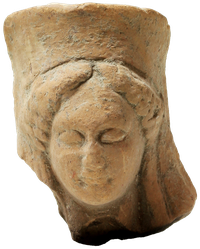Taranto
 |
 |
 |
Taranto is located on the gulf of the same name in southern Italy, in what is now the region of Puglia. According to ancient sources, it was founded in 706 BC by Spartan settlers from the Greek motherland. Taras, a son of Poseidon and a nymph, is considered the mythical founder of the city (Ktistes) (Pausanias 10, 10, 8). The location on a narrow headland favoured the development of a busy trading port and a flourishing prosperous city. After the devastating defeat of the Tarentines by the native population of the Iapygians in 473 BC,[1] democratic forms of government replaced the aristocratic system of rule. Under the leadership of the strategist and philosopher Archytas, the city reached the peak of its power in the early 4th century BC.
Ancient writers report famous works of art. The colossal statue of Heracles, created by Lysipp, reached Rome as war booty[2]. Only a few monuments of ancient Taras have survived. In the Piazza Castello, two Doric columns of a temple from the 1st quarter of the 6th century BC could be re-erected. Without any valid justification, one speaks of the so-called Temple of Poseidon, but the composition of the recovered votive offerings indicates the worship of a female deity.
There is evidence of figurative clay sculpture in Taranto as early as the 7th century BC. Especially between the 6th and 4th centuries BC, terracotta manufacture flourished. At the beginning of the 19th century, international interest in clay figurines awoke. Legal and illegal excavations produced tens of thousands of terracotta statuettes from the so-called "stipi" (votive deposits, pits, shafts). About 20,000 of them went to the National Museum in Naples, for example. Numerous objects from looted excavations found their way all over the world via the art trade.
The Collection of Classical Antiquities at JLU in Giessen preserves six heads of clay figurines that can be assigned to a Taranto workshop on the basis of peculiarities of style and attributes. Written documents on the origin of the pieces were lost during the Second World War.
[1] Herodot 7, 170.
[2] Strabon 6, 3, 1.
Taranto Symposiastes
A symposium is understood to be the communal evening feast of members of the urban elite in Greek antiquity. As a fixed social institution of this upper class, the symposium had far-reaching effects on political and religious life, as well as on literature and art. Statues of men in marble, such as that of Geneleos from Samos, and statuettes in limestone, bronze or terracotta, give an idea of the participants in these events, the symposiasts[1]. Vase paintings[2] and reliefs have depicted them at various stages of the symposium and engaged in a wide variety of activities. The figurines of Taranto differ from those from other landscapes of the Greek world in two respects; on the one hand by their enormous number - from the "Fondo Giovinazzi" alone about 25,000 clay statuettes are said to have been recovered - and on the other hand by their specific, sometimes highly elaborate imaginative headdresses. In archaic and classical times, such statuettes were offered to the gods as votive gifts. To make room for new votives, the earlier ones were cleared away and deposited in depots on the grounds of the sanctuary. In such "stipi" - pits - the majority of the clay symposiasts, which can only exceptionally be assigned to a specific deity, were found.
The interpretation of the statuettes is not complete. They are regarded as figures of the gods and as images of heroes of the deceased, or they were seen as the self-portrayal of the urban elites. Today, one tries as far as possible to include the place of discovery in one's considerations, and one bases one's interpretation on the different times of their production.
The collection of antiquities at JLU in Giessen contains three terracotta heads which, according to their parallels, can be assigned with certainty to the Taranto symposiasts.
[1] B. Freyer-Schauenburg, Samos 11, 1974, 116-118 no. 63 pl. 51; J.M. Dentzer, Le motif du banquet couché dans le proche-orient et le monde grec du VIIème au Ième siècle avant J.C. (Rom 1982) pl. 24.
[2] A. Schäfer, Unterhaltung beim griechischen Symposion (Mainz 1997).
 |
 |
 |
